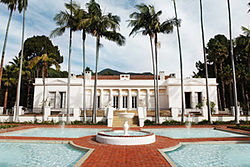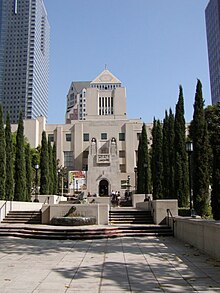Bertram Goodhue
Bertram Grosvenor Goodhue | |
|---|---|
New Haven Collegiate and Commercial Institute | |
| Occupation | Architect |
| Parent(s) | Charles Wells Goodhue, Helen Grosvenor (Eldredge) Goodhue |
| Practice | Renwick, Aspinwall and Russell; and Cram, Goodhue and Ferguson |

Bertram Grosvenor Goodhue (April 28, 1869 – April 23, 1924) was an American architect celebrated for his work in Gothic Revival and Spanish Colonial Revival design. He also designed notable typefaces, including Cheltenham and Merrymount for the Merrymount Press. Later in life, Goodhue freed his architectural style with works like El Fureidis in Montecito, one of the three estates designed by Goodhue.
Early career
Goodhue was born in
Cram and Goodhue
Independent practice
Early projects
When Goodhue left to begin his own practice in 1914, Cram had already created his dreamed of
Goodhue departed into a series of radically different stylistic experiments over his independent career. His first was the
Spanish Colonial Revival projects
In California, in 1915, Bertram Goodhue re-interpreted masterful

Later projects

Later Goodhue's architectural creations became freed of architectural detail and more Romanesque in form, although he remained dedicated to the integration of sculpture, mosaic work, and color in his surface architectural details. Towards the end of his career, he arrived at a highly personal style, a synthesis of simplified form and a generalized archaic quality, and those innovations paved the way for others to transition to modern architectural idioms. This style is seen in his last major projects: the 1926 Mediterranean revival and Egyptian revival Los Angeles Public Library; the Nebraska State Capitol; and in his 1922 entry for the Chicago Tribune Tower competition.
Influence

Goodhue died in 1924 in New York City. He was interred within a wall vault in the north (left-hand)
Collaboration
Over the course of his career, Goodhue relied on frequent collaborations with several significant artists and artisans. These included architectural sculptor
After Goodhue's unexpected death in 1924, many of his designs and projects were brought to completion by architect Carleton Winslow Sr. in California, the successor firm of Mayers Murray & Phillip in New York, and other former associates. Goodhue's offices had employed, before they established their own independent practices and reputations, designers and architects such as Raymond Hood, Carleton Winslow Sr., Clarence Stein, and Wallace Harrison. Thematic consultant Hartley Burr Alexander, Lee Lawrie, and Hildreth Meiere reassembled in the 1930s for the Rockefeller Center project collaboration with Raymond Hood.
Legacy
In a recent dissertation on American regional architecture in California and Hawaii, Goodhue is credited with creating a distinctive interpretation of
Along with
A significant archive of Goodhue's correspondence, architectural drawings, and professional papers is held by the Avery Architectural and Fine Arts Library at Columbia University in New York City.
James Perry Wilson, an architect and painter responsible for many of the Natural History dioramas at the American Museum of Natural History, was employed by Bertram Goodhue Associates before transitioning to museum work.[7]
Projects



- Ashmont, Massachusetts, 1892
- Sturgis & Brigham), Lady Chapel Interior, 1894 (as Cram & Goodhue)[8]
- Public Library, Nashua, New Hampshire, 1902
- Grace Church Chapel, Chicago, Illinois, 1904
- The Chapel and the original campus of the United States Military Academy, West Point, New York, 1906
- El Fureidis in Montecito, California, 1906
- Saint Thomas Churchin New York City, 1906
- St. James' Episcopal Church in South Pasadena, 1907[9]
- First Baptist Church, Pittsburgh, Pennsylvania, 1909
- St. John's Episcopal Church in West Hartford, Connecticut, 1909
- Kitchi Gammi Club, Duluth, Minnesota, 1912[10]
- St. Paul's Episcopal Church, Duluth, Minnesota, 1912[11]
- Church of the Intercession, New York, 1913
- St. Bartholomew's Church, New York City, 1913
- Hotel Washington, Colón, Panama, 1913
- Saint Mark's Episcopal Church, Mount Kisco, New York, 1913
- Trinity Episcopal Church, Asheville, North Carolina, 1913[12][a]
- Ford Hall, Rutgers University, 1914
- Hartley Building, Duluth, Minnesota, 1914[14]
- Virginia Military Institute, Lexington, Virginia, 1914
- Cavour Hartley House, Duluth, Minnesota, 1915[15]
- El Prado Quadrangle, the Fine Arts Gallery and the California Building (now the San Diego Museum of Us), all part of the Panama–California Exposition in Balboa Park, San Diego, California, 1915
- Chicago, Illinois, commissioned 1918, built 1925–1928
- The town plan and several buildings for the "Million Dollar Ghost Town", Tyrone, New Mexico
- Grolier Club Library, New York City, 1917
- St. Vincent Ferrer, New York City, 1920
- Honolulu, Hawaii, 1915–1920
- First Congregational Church (Montclair, New Jersey)[16]
- San Diego, California, 1921
- St. Mary's-in-Tuxedo Episcopal Church, Tuxedo Park, New York, 1922.[17]
- Paris, France, War Memorial and Cloister Wall, 1922-1923.
- Los Angeles Central Library, Downtown Los Angeles, California, 1924
- Nebraska State Capitol, Lincoln, Nebraska, 1924
- National Academy of SciencesBuilding, Washington, D.C., 1924
- Master Plan, the Physics Building, Dabney Hall, and other campus buildings for the California Institute of Technology (Caltech), Pasadena, California, 1924
- Fraternity House of the Rensselaer Society of Engineers, Troy, New York, 1922–1924
- Trinity English Lutheran Church, West End Historic District, Fort Wayne, Indiana, 1924
- Chicago, Illinois, commissioned 1919, completed in 1931 by the successor firm of Mayers Murray & Phillip.
- Honolulu, Hawaii, commissioned 1922, completed 1927 by Hardie Phillip.
- Christ Church Cranbrook, Bloomfield Hills, Michigan, 1925–1928.
- Memorial Flagpole or Goodhue Flagpole, Pasadena, California, 1927[18][19]
- Honolulu, Hawaii, 1927–1929 (completed by Hardie Phillip).
- Honolulu, Hawaii, completed 1931 by Hardie Phillip.
- House of Philip W. Henry, Linden Circle, Briarcliff Manor, New York[20]
- Wolf's Head Society "New Hall", Yale University, New Haven, Connecticut, designed c. 1924, built posthumously
References
- Notes
- ^ Said to be similar to Louisville, Kentucky's Church of Our Merciful Saviour, possibly also designed by Goodhue.[13]
- Citations
- ^ Gray, Christopher (January 22, 2006). "A Renowned Architect's Home of His Own". The New York Times – via NYTimes.com.
- ^ "American Academy of Arts and Letters – Deceased Members". Artsandletters.org. Archived from the original on July 26, 2011. Retrieved August 15, 2012.
- ^ a b McCall, Wayne; Andree, Herb; Young, Noel; Halloran, Patricia (1980). Santa Barbara Architecture: From Spanish Colonial to Modern. Santa Barbara: Capra Press.
- ^ Aran, Berge (2005). Austin Val Verde, a Montecito Masterpiece. Santa Barbara: Austin Val Verde Foundation.
- ^ Herold, Ann (June 2, 2005). "A glorious sight unseen". Los Angeles Times.
- ^ a b c Penkiunas 1990
- ^ "Biographical Data on James Perry Wilson", AMNH Archives
- ^ Southworth, Susan; Southworth, Michael (2008). AIA Guide to Boston (Third ed.). Guildford, Connecticut: GPP. p. 29.
- ^ "Our History". St. James' Episcopal Church.
- ^ Scott 1974, p. 98
- ^ Scott 1974, p. 129
- ^ "Trinity Episcopal Church Asheville". Trinity Episcopal.
- ^ Hedgepeth, Marty (September 24, 1980). "National Register of Historic Places Inventory/Nomination: Church of Our Merciful Saviour". National Park Service. Retrieved March 1, 2018. With photo.
- ^ Scott 1974, p. 99
- ^ Scott 1974, p. 131
- OCLC 233535656.
- ^ "A Tour of Our Campus". Archived from the original on June 2, 2021. Retrieved July 12, 2021.
- ^ "Public Memorials and Monuments". City of Pasadena. Retrieved September 17, 2020.
- ^ Rick Thomas (January 16, 2019). "Pasadena's Historic Memorial Flagpole". South Pasadenan.
- OCLC 22274920.
- Works cited
- Penkiunas, Daina Julia (1990). American Regional Architecture in Hawaii: Honolulu, 1915–1935 (Ph.D. dissertation). University of Virginia.
- Scott, James Allen (1974). Duluth's Legacy: Volume 1: Architecture. photography and graphic design by John R. Ulven Jr.; ill. by Robert T. Calton. City of Duluth through the Office of the Dept. of Research & Planning. OCLC 950568058.
- Further reading
- Oliver, Richard. Bertram Grosvenor Goodhue. Cambridge, Massachusetts: MIT Press, 1983 for the Architectural History Foundation. xii + 297 pp.; 146 illustrations, bibliography, index. ISBN 978-0-262-15024-8
- Whitaker, Charles Harris, ed. With text by Hartley Burr Alexander, Ralph Adams Cram, George Ellery Hale, Lee Lawrie, and C. Howard Walker. Bertram Grosvenor Goodhue: Architect and Master of Many Arts. New York: Press of the American Institute of Architects, Inc., 1925. (Reprint, New York: Da Capo Press, 1976. ISBN 0-306-70826-4.)
- Wyllie, Romy. Bertram Goodhue: His Life and Residential Architecture. New York: W. W. Norton & Company, 2007. ISBN 978-0-393-73219-1
External links
- Bertram Grosvenor Goodhue architectural drawings and papers, 1882–1980. Held by the Department of Drawings & Archives, Avery Architectural & Fine Arts Library, Columbia University.
- Church of St. Vincent Ferrer (New York, N.Y.) architectural drawings, 1908–1928. Held by the Department of Drawings & Archives, Avery Architectural & Fine Arts Library, Columbia University.
- Christ Church Cranbrook, Bloomfield Hills, MI
- Online history of Hotel Washington in Panama
- St. John's Episcopal Church, West Hartford, Connecticut
- Font Designer – Bertram G. Goodhue
- About the National Academy of Sciences Building, Washington, D.C.
- An Alphabet of Celebrities illustrated by Bertram Goodhue, available in full text and with full zoomable page images in the University of Florida Digital Collections
- UNCG American Publishers' Trade Bindings: Bertram Goodhue Archived April 3, 2012, at the Wayback Machine
